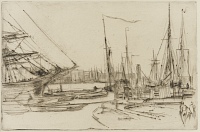Etchings Institutions search term: grolier club
From Billingsgate | ||
| Number: | 165 | |
| Date: | 1876/1877 | |
| Medium: | drypoint | |
| Size: | 152 x 229 mm | |
| Signed: | butterfly at lower right (6-final) | |
| Inscribed: | no | |
| Set/Publication: | 'Cancelled Plates', 1879 | |
| No. of States: | 8 | |
| Known impressions: | 28 | |
| Catalogues: | K.168; M.164; W.130 | |
| Impressions taken from this plate (28) | ||
KEYWORD
TITLE
'From Billingsgate' (1870s, possibly Whistler). 2
'From Billingsgate' (1881, Union League Club). 3
'From Billingsgate' (1877, Whistler). 4
'A Sketch from Billingsgate' (1886, Frederick Wedmore (1844-1921)). 5
''Billingsgate (a sketch from)? Wedmore 130'.' (1890/1892, Beatrice Whistler (1857-1896)). 6
'A Sketch from Billingsgate' (1909, Howard Mansfield (1849-1938)). 7
'From Billingsgate' is Whistler's original title, and the addition of 'A Sketch from' is unnecessary.
3: New York 1881 (cat. no. 148).
4: Whistler to Royal Collection, Windsor Castle Library, [19/22 October 1877], GUW #12736.
5: Wedmore 1886 A (cat. no. 130).
6: List, [1890/1892], GUW #12715.
7: Mansfield 1909 (cat. no. 164).
DESCRIPTION
SITE

